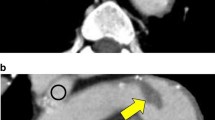Abstract
Stroke and other thromboembolic events are mainly caused by emboli from heart, aorta and other arteries. In this paper we describe a group of 5 middle-aged patients suffering from emboli caused by large thrombi in the aorta. Since the development of giant thrombi under high flow conditions in the aorta is a pathophysiological process which is not well understood, a model of flow distribution by numerically simulating the Navier–Stokes equation for an incompressible fluid was generated. This model simulated how such thrombi may develop in the aorta. We hypothesize that large thrombi issuing from the aortic vessel wall represent a underestimated entity in middleaged persons and are probably overlooked as the cause of stroke or other embolic events in some cases.


Similar content being viewed by others
References
Sheikhzadeh A, Ehlermann P (2004) Atheromatous disease of the thoracic aorta and systemic embolism. Clinical picture and therapeutic challenge. Z Kardiol 93(1):10–17
Kronzon I, Tunick PA (1997) Atheromatous disease of the thoracic aorta: pathologic and clinical implications. Ann Intern Med 126(8):629–637
Tunick PA, Kronzon I (2000) Atheromas of the thoracic aorta: clinical and therapeutic update. J Am Coll Cardiol 35(3):545–554
Lippi G, Franchini M, Targher G (2011) Arterial thrombus formation in cardiovascular disease. Nat Rev Cardiol 8(9):502–512
Shahcheraghi N et al (2002) Unsteady and three-dimensional simulation of blood flow in the human aortic arch. J Biomech Eng 124(4):378–387
Svedlund S et al (2009) Retrograde blood flow in the aortic arch determined by transesophageal Doppler ultrasound. Cerebrovasc Dis 27(1):22–28
Fung YC (1981) Chapter 3: the flow properties of blood. In: Biomechanics: mechanical properties of living tissues, Springer, New York
Chandran KB( (1993) Flow dynamics in the human aorta. J Biomech Eng 115(4B):611–616
Morris L et al (2005) 3-D numerical simulation of blood flow through models of the human aorta. J Biomech Eng 127(5):767–775
Lloyd-Jones D et al (2009) Heart disease and stroke statistics–2009 update: a report from the American Heart Association Statistics Committee and Stroke Statistics Subcommittee. Circulation 119(3):480–486
Acknowledgments
C.K. and W.H. acknowledge support from the Centre for Quantum Engineering and Space–Time Research QUEST.
Author information
Authors and Affiliations
Corresponding author
Rights and permissions
About this article
Cite this article
Stoevesandt, D., Klempt, C., Scheubel, R. et al. Embolic events caused by aortic thrombi: An underestimated entity?. J Thromb Thrombolysis 35, 223–227 (2013). https://doi.org/10.1007/s11239-012-0775-x
Published:
Issue Date:
DOI: https://doi.org/10.1007/s11239-012-0775-x




